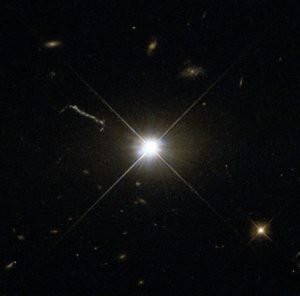
ESA/Hubble & NASA) – click to enlarge
A quasar is a distant, and hence highly redshifted, active galactic nucleus, which can shine with over 100 times the luminosity of all the stars in an entire galaxy.
All galaxies are believed to contain a supermassive black hole at their centre. In the early universe, when galaxies were first forming and merging, these black holes consumed vast amounts of material from surrounding gas, dust and stars. Gravitational and frictional forces cause this material to heat to enormous temperatures as they spiral into the black hole from its accretion disk. This causes the material to become highly luminous, converting as much as 10 per cent of the material’s mass into electromagnetic radiation.
Some Quasars, such as 3C 273 (shown above), have been observed to emit jets of ionised matter as an extended beam along the axis of rotation.
Since light travels at a finite speed, it can take billions of years to reach us from near to the edge of the observable universe. Hence, we can observer these active galactic nucleus that existed in the early universe around 12 billion years ago, or one to two billion years after the big bang.
Due to their extreme distance and the expansion of the universe, they are moving away from us at relativistic speeds causing their light to be highly redshifted from around 0.06 to redshifts of over 7. Hubble’s law can be used to determine that these quasar are between around 600 million and 28 billion light-years away from us.
When quasars were first observed in the 1960s, astronomers were puzzled by what these luminous objects could be. They were termed quasars from a contraction of the word quasi-star, as they appeared to be point-like sources of radiation, but with mysterious broad absorption lines in their spectra, rather than the sharply resolved absorption lines in the spectrum of a star. These spectral lines were later confirm to be highly redshifted absorption lines of hydrogen and other chemical elements.